Key takeaways
- The Bitcoin Spot ETF (launched on January 11, 2024) has received a cumulative net inflow of US$15.1 billion as of June 15, 2024.
- Nine issuers are working on launching 10 Ethereum spot ETFs in the United States. The U.S. Securities and Exchange Commission (SEC) approved all 19b-4 filings on May 23, and the ETFs are expected to begin trading in July 2024.
- As with the Bitcoin ETF, we believe the primary source of net inflows are independent investment advisors, or investment advisors affiliated with banks, brokers/dealers.
- We estimate that the net inflow of Ethereum ETF in the first five months will account for 20-50% of the net inflow of Bitcoin ETF in the same period. Our estimated target is 30%, which means a monthly net inflow of 1 billion Dollar.
- Overall, we believe ETHUSD is more price sensitive to ETF inflows than BTC, as a large portion of the total ETH supply is locked in staking, cross-chain bridges, and smart contracts, while centralized exchanges hold larger amounts. few.
For months, observers and analysts have been discounting the likelihood of the U.S. Securities and Exchange Commission (SEC) approving a spot Ethereum exchange-traded product (ETP). The pessimism stems from the SEC's reluctance to explicitly recognize ETH as a commodity, the market's lack of information about contacts between the SEC and potential issuers, and the SEC's ongoing investigations and enforcement actions related to the Ethereum ecosystem.
However, all current spot Ethereum ETP applications have been approved by the SEC. We look forward to the actual rollout of these tools once the S-1 petition becomes effective (which we expect to be sometime in the summer of 2024).
This report will refer to the performance of Bitcoin spot ETP to predict the demand for Ethereum ETP after its launch. We estimate that Ethereum spot ETPs will achieve net inflows of approximately $5 billion in the first five months of trading (accounting for approximately 30% of Bitcoin ETP net inflows).
background
There are currently 9 issuers competing to launch 10 exchange-traded products (ETPs) for spot ETH. Several publishers have dropped out over the past few weeks. ARK has chosen not to partner with 21Shares to launch an Ethereum ETP, while Valkyrie, Hashdex and WisdomTree have withdrawn their applications.
The chart below shows the current status of applicants sorted by 19b-4 filing date:
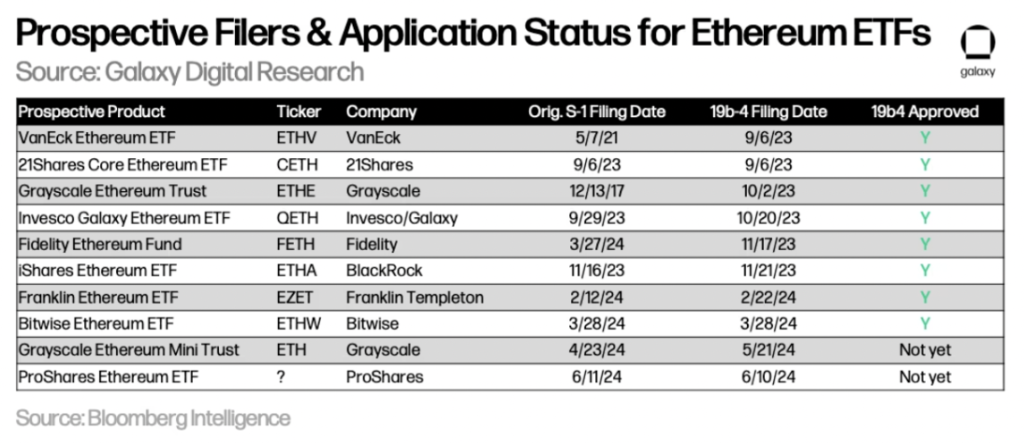
Grayscale is looking to convert Grayscale Ethereum Trust (ETHE) into an ETP, just as the company did with its Grayscale Bitcoin Investment Trust (GBTC), but Grayscale has also applied for a "mini" Ethereum ETP.
On May 23, the U.S. Securities and Exchange Commission approved all 19b-4 filings (the rule change that allows stock exchanges to finally list ETH spot ETPs), but now each issuer needs to go back and forth with regulators about their registration announcement.
Until the SEC allows these S-1 filings (or S-3 filings in the case of ETHE) to go into effect, the products themselves cannot actually begin trading. Based on our research and Bloomberg reports, we believe that the Ethereum spot ETP may begin trading as early as the week of July 11, 2024.
Bitcoin ETF Experience
The Bitcoin ETF has been launched for nearly 6 months and can be used as a benchmark for predicting the likely popularity of the Ethereum spot ETF.
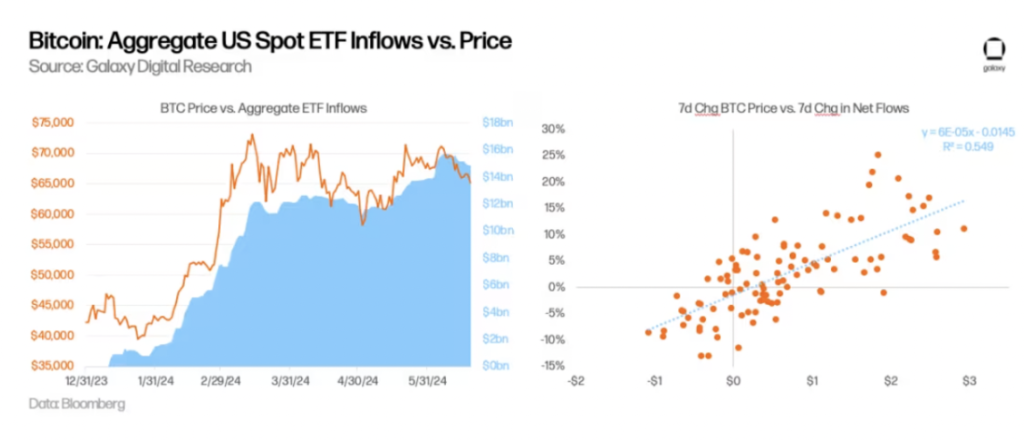
Source: Bloomberg
Here are some observations from the first few months of Bitcoin spot ETP trading:
- So far, inflows have been trending upward. As of June 15, the U.S. spot Bitcoin ETF has accumulated net inflows of more than $15 billion since its launch, with an average net inflow of $136 million per trading day. The total amount of BTC held by these ETFs is approximately 870,000 BTC, accounting for 4.4% of the current supply of BTC. The trading price of BTC is approximately US$66,000, and the total AUM of all US spot ETFs is approximately US$58 billion (note: before the launch of the ETF, GBTC held approximately 619,000 BTC).
- ETF inflows are partly responsible for the rise in BTC prices. By regressing the 1-week change in BTC price and ETF net inflows, we calculate an r-sq of 0.55, indicating that the two variables are highly correlated. Interestingly, we also find that price changes are a leading indicator of inflows, rather than the other way around.
- GBTC has always been a major hidden danger for the overall flow of ETFs. GBTC experienced significant outflows in the early months since converting the trust to an ETF. GBTC daily outflows peaked in mid-March, with outflows of $642 million on March 18, 2024. Outflows have since moderated, and GBTC even experienced a few days of positive net inflows starting in May. As of June 15, the balance of BTC held by GBTC has dropped from 619,000 to 278,000 since the launch of the ETF.
ETF demand is primarily driven by retail investors, with institutional demand picking up
The 13F filing shows that as of March 31, 2024, more than 900 U.S. investment companies held Bitcoin ETFs, with holdings worth approximately $11 billion, accounting for approximately 20% of total Bitcoin ETF holdings, indicating that most of the demand It is driven by retail investors. The list of institutional buyers includes major banks (e.g., JPMorgan Chase, Morgan Stanley, Wells Fargo), hedge funds (e.g., Millennium, Point72, Citadel) and even pension funds (e.g., Wisconsin Investment Council).
Wealth management platform has not yet started buying Bitcoin ETFs for clients
The largest wealth management platform has not yet allowed its brokers to recommend Bitcoin ETFs, although Morgan Stanley is reportedly exploring letting its brokers solicit clients to buy. We wrote in our report "Market Size for Bitcoin ETFs" that it could be years before wealth management platforms, including broker-dealers, banks and RIAs, help clients purchase Bitcoin ETFs. Inflows from wealth management platforms have been minimal so far, but we believe it will be a significant catalyst for Bitcoin adoption in the near to medium term.

GBTC daily liquidity after ETF approval (USD)
Estimating potential Ethereum ETF inflows
Referring to the situation of Bitcoin ETP, we can approximately estimate the potential market demand for Ethereum ETP.

Relative size of BTC vs. ETH ETP markets
To estimate potential Ethereum ETF inflows, we applied a BTC/ETH multiple to U.S. Bitcoin spot ETF inflows based on the relative asset sizes of the multiple markets where BTC and ETH trade. As of May 31st:
- The market capitalization of BTC is 2.9 times that of ETH.
- Across all exchanges, the futures market for BTC is roughly 2 times larger than that of ETH, based on open interest levels and trading volume. Specific to CME, BTC’s open interest is 8.4 times that of ETH, while BTC’s daily trading volume is 4.2 times that of ETH.
- The AUM of various existing funds (by Grayscale Trust, Futures, Spot and Selected Global Markets) shows that the size of BTC funds is 2.6 times – 5.3 times that of ETH funds.
Based on the above, we believe that Ethereum spot ETF inflows will be approximately 1/3 of Bitcoin spot ETF inflows (estimate range 20%-50%).
Applying this information to the $15 billion in Bitcoin spot ETF inflows through June 15, it means that in the first five months after the launch of the Ethereum ETF, monthly inflows were approximately $1 billion (estimate range: per US$600 million to US$1.5 billion per month).
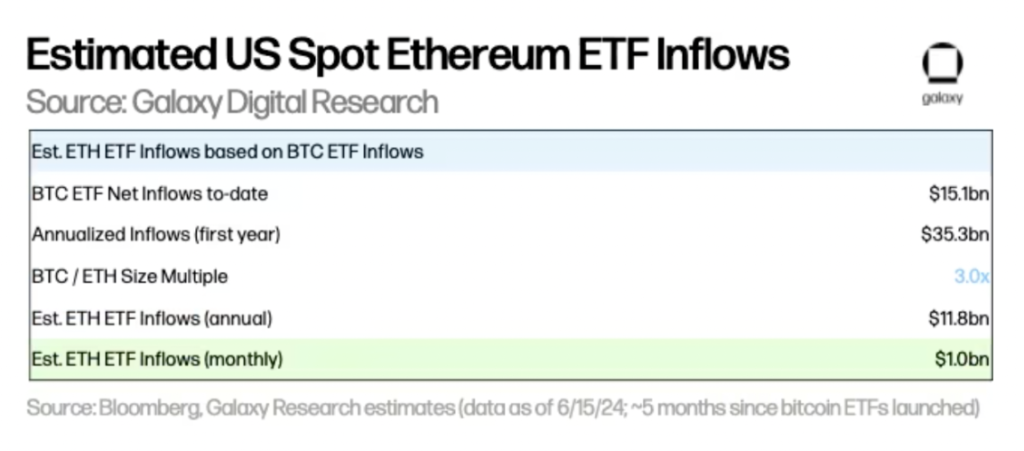
U.S. Spot Ethereum ETF Inflow Estimation
We saw some valuations lower than our forecasts due to several factors. Having said that, our previous report forecast first-year Bitcoin ETF inflows of $14 billion, assuming the entry of wealth management platforms, but Bitcoin ETFs have already seen significant inflows before these platforms enter. Therefore, we recommend caution when predicting low demand for Ethereum ETFs.
Some structural/market differences between BTC and ETH will affect ETF flows:
Due to the lack of staking rewards, demand for spot Ethereum ETFs may be affected. Unstaking ETH loses the opportunity cost of (i) inflation rewards paid to validators, (ii) priority fees paid to validators, and MEV revenue paid to validators through relayers.
Based on data from September 15, 2022 to June 15, 2024, we estimate that the annualized opportunity cost of forgoing staking rewards is 5.6% for spot ETH holders (using year-to-date data the result is 4.4%) , which is a big difference.
This would make spot Ethereum ETFs less attractive to potential buyers. Note that ETPs offered elsewhere outside the United States (such as Canada) provide holders with additional yields through staking.
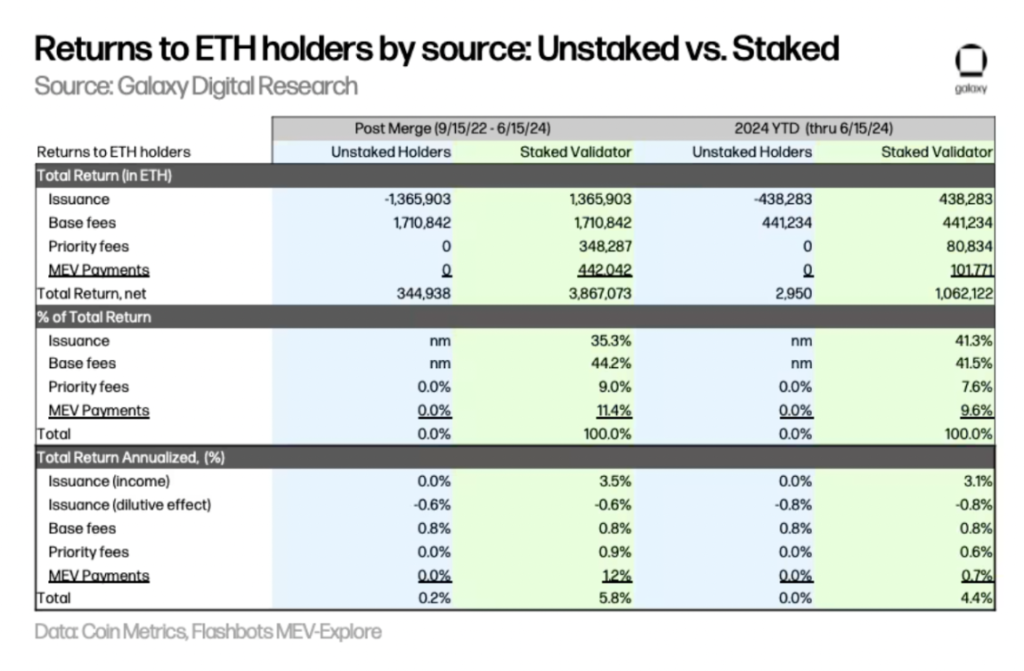
Additionally, Grayscale’s ETHE may be a drag on Ethereum ETF inflows. Just as the GBTC Grayscale Trust experienced significant outflows as an ETF converted, so did the ETHE Grayscale Trust converting to an ETF.
Assuming ETHE's outflow rate matches GBTC's outflow rate in the first 150 days (i.e. 54.2% of the trust supply was withdrawn), we estimate that ETHE's outflow volume will be approximately 319,000 ETH per month, which at the current price of $3,400 will Reaching monthly outflows of US$1.1 billion or an average daily outflow of US$36 million.
Note that the tokens held by these trusts as a percentage of their respective total supply are: 3.2% for BTC and 2.4% for ETH. This shows that the ETHE ETF conversion puts less pressure on the price of ETH than GBTC. In addition, unlike GBTC, ETHE will not face forced sales due to bankruptcy cases (such as 3AC or Genesis), which further supports the idea that the selling pressure associated with ETH and Grayscale Trust will be relatively less than BTC.
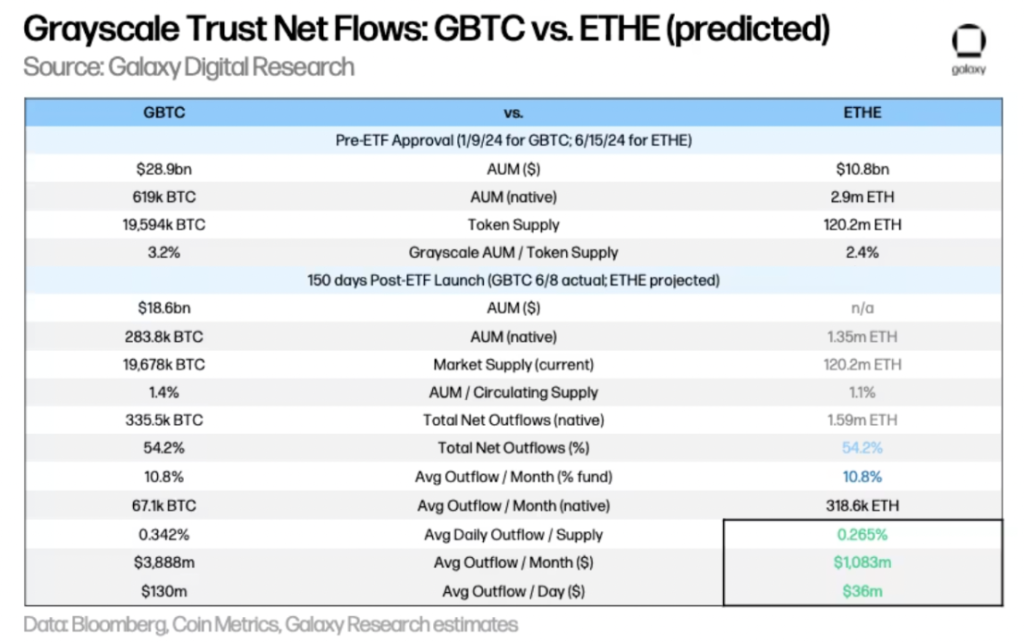
Basis trading may be driving hedge fund demand for Bitcoin ETFs. Basis trading may be driving demand for Bitcoin ETFs from hedge funds looking to arbitrage the difference between Bitcoin's spot and futures prices.
As mentioned earlier, 13F filings show that as of March 31, 2024, more than 900 U.S. investment companies held Bitcoin ETFs, including some well-known hedge funds such as Millennium and Schonfeld.
Throughout 2024, ETH’s financing rates on various exchanges are on average higher than BTC, indicating that (i) the demand for long ETH is relatively large, and (ii) spot Ethereum ETFs may bring more basis trading. Hedge Fund Demand.

Factors affecting the price sensitivity of ETH and BTC
Since our estimated ratio of Ethereum ETF inflows to market cap is roughly equal to the ratio of Bitcoin flows to market cap, we expect the price impact to be roughly the same, all else being equal. However, there are several key differences in the supply and demand of the two assets, which may cause Ethereum price to be more sensitive to ETF flows:
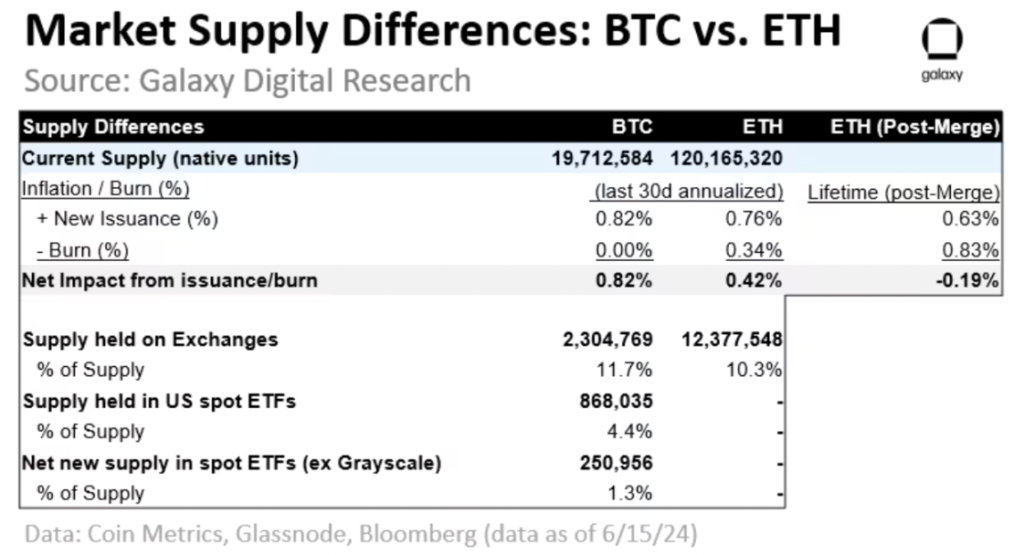
Supply held by exchanges: Currently, exchanges hold a larger proportion of BTC supply than ETH (11.7% vs. 10.3%), suggesting that ETH supply may be tighter and assuming inflows are proportional to market cap, ETH prices Sensitivity will be higher (note: this metric relies heavily on exchange address attribution and varies widely between different data providers).
Inflation and destruction: Following the latest halving on April 20, 2024, BTC’s annual inflation rate is approximately 0.8%. Post-Ethereum merger, ETH has experienced net negative issuance (-0.19% annualized) as new issuance paid to stakers (+0.63%) has been offset by base fees burned (-0.83%). In the latest month, relatively low ETH base fees (-0.34% annualized) failed to offset new issuance (+0.76% annualized), resulting in a net positive annualized inflation rate of +0.42%.
Supply held by ETFs: Since launch, net BTC entering U.S. spot ETFs (excluding starting balances of GBTC) has totaled 251,000 BTC, accounting for 1.3% of current supply. If calculated on a one-year basis, the ETF would absorb 583,000 BTC, or 3.0% of the current supply of BTC, which would far exceed the dilution from miner rewards (0.81% inflation rate).
However, the actual market liquidity available for purchase is much lower than the reported current supply. We believe a better representation of the available market supply of each asset in an ETF would include adjustments for factors such as pledged supply, dormant/lost, and supply held in cross-chain bridges and smart contracts:
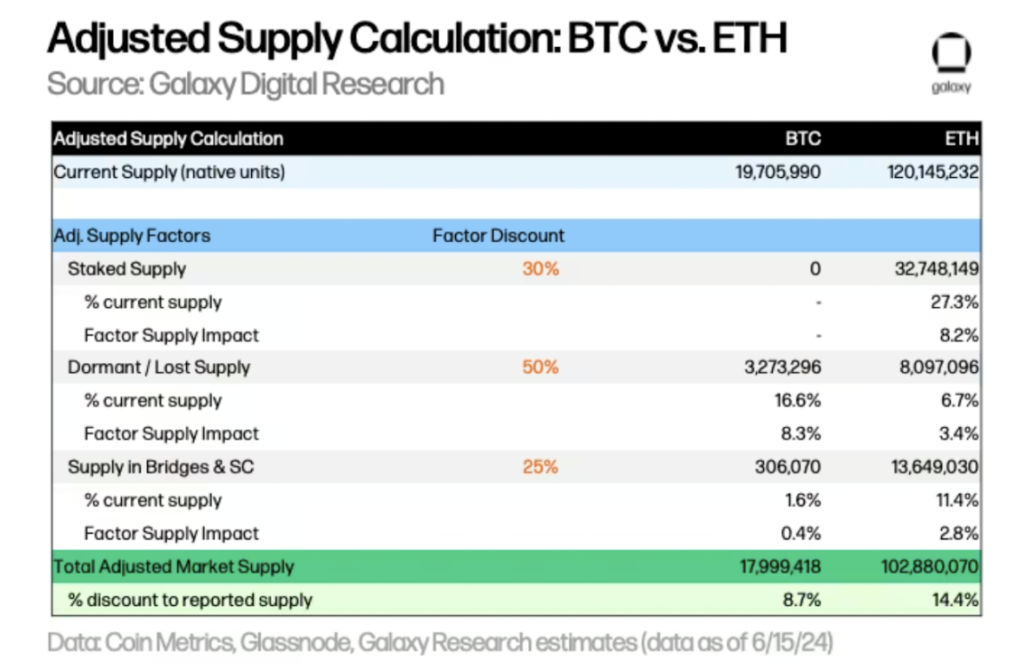
BTC and ETH adjusted supply calculations
- Staking Supply (Discount: 30%): Staking reduces the amount of tokens available for purchase by the ETF. Currently, Bitcoin does not have a staking feature. Ethereum requires pledging ETH to protect the network, but pledgers can unpledge part of the ETH and use it elsewhere. Currently, the amount of staked ETH accounts for approximately 27% of the current supply of ETH. We use a 30% discount to estimate the available market supply, resulting in a supply discount of 8.2%.
- Dormant/Lost Supply (Discount: 50%): A portion of BTC and ETH is considered irrecoverable (e.g. lost keys, ship accident), so the available supply is reduced. We calculate dormant/lost supply using Bitcoin addresses that have been dormant for 10+ years and Ethereum addresses that have been dormant for 7+ years, which account for 16.6% and 6.7% of the current supply of BTC and ETH respectively. We apply a 50% discount rate to this balance because the supply held in some of these supposedly dormant addresses may come back online at any time.
- Supply in cross-chain bridges and smart contracts (Discount: 25%): This is supply locked in cross-chain bridges and contracts for production purposes. For Bitcoin, the BTC balance held by BitGo for wrapped BTC (wBTC) is approximately 153,000 BTC, and we estimate that approximately the same amount is locked in other cross-chain bridges, totaling approximately 1.6% of the BTC supply. ETH locked in smart contracts accounts for 11.4% of the current supply. We apply a lower discount to this balance than the pledged supply, i.e. 25%, because we assume this supply is more liquid than the pledged supply (i.e. may not be subject to the same locking requirements and withdrawal queues).
Applying discount weights to each factor to calculate the adjusted supply of BTC and ETH, we estimate that the available supply of BTC and ETH is 8.7% and 14.4% less than the reported current supply, respectively.
Overall, ETH's price sensitivity to relative market cap-weighted inflows should be higher than that of BTC due to (i) lower available market supply based on adjusted supply factors, (ii) higher percentage supply on exchanges low, and (iii) low inflation. Each of these factors should have a multiplier effect (rather than an additive effect) on price sensitivity, with prices tending to be more sensitive to larger changes in market supply and liquidity.
Looking to the future
Going forward, we face several issues regarding adoption and second-order effects:
- How should allocators view BTC and ETH? Will existing holders migrate from Bitcoin ETFs to ETH? For configurators, some rebalancing is expected. Will Spot Ethereum ETF Attract New Buyers Not Yet Buying BTC? What will be the mix of potential buyers? Will they only hold BTC, only ETH, or both?
- When can the staking function be added? Will the absence of staking rewards have an impact on spot Ethereum ETF adoption? Will investment demand for DeFi, tokenization, NFTs, and other crypto-related applications drive further adoption of Ethereum ETFs?
- What potential impact does this have on other Altcoin? After Ethereum, are we more likely to see other Altcoin ETFs approved?
Overall, we believe the launch of a spot Ethereum ETF will have a large positive impact on adoption of Ethereum and the broader cryptocurrency market, for two main reasons:
(i) Expanding the reach of cryptocurrency
(ii) Cryptocurrencies gain greater acceptance through formal recognition by regulators and trusted financial services brands.
ETFs can expand retail and institutional coverage, provide broader distribution through more investment channels, and support the use of Ethereum in more investment strategies in investment portfolios. Additionally, greater understanding of Ethereum among financial professionals will accelerate investment and adoption.






